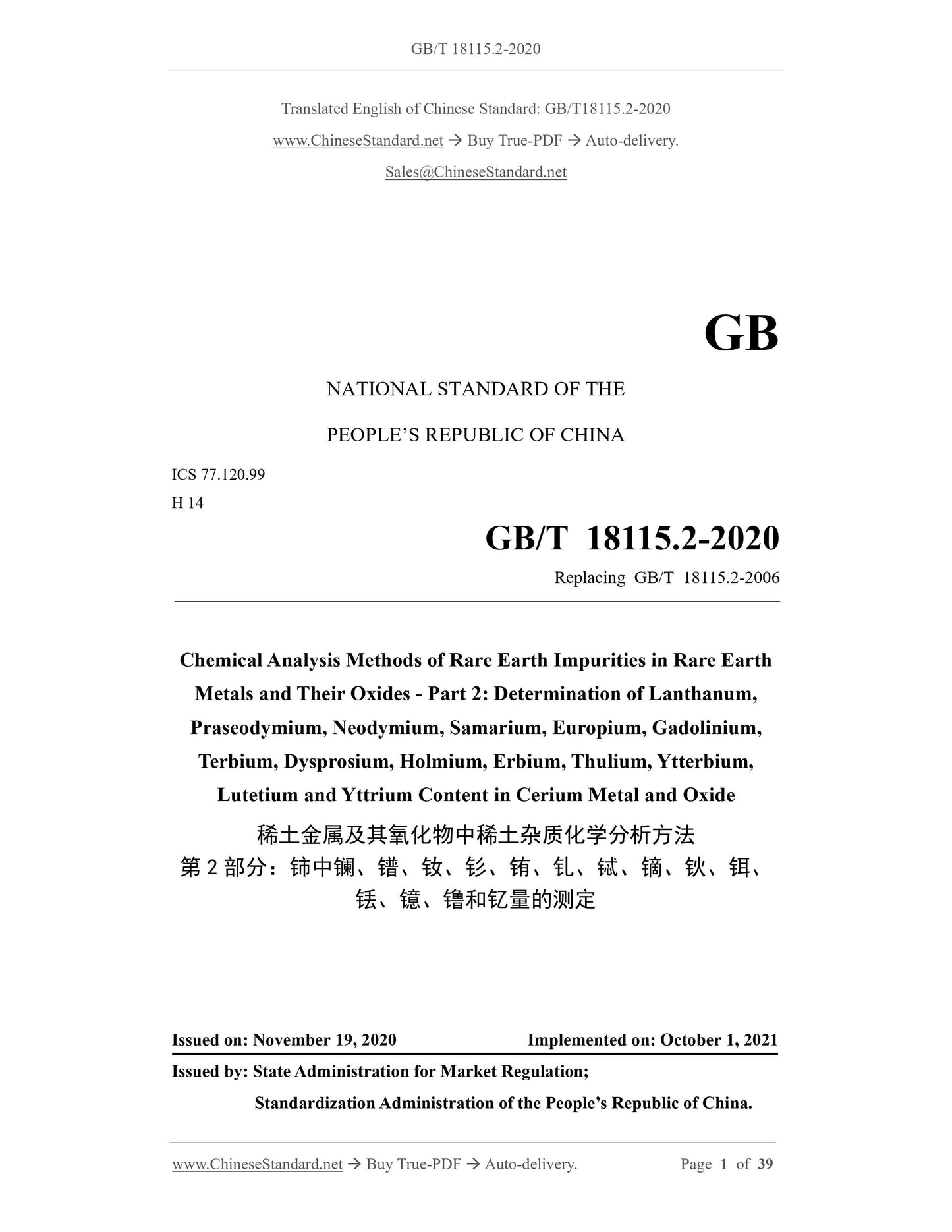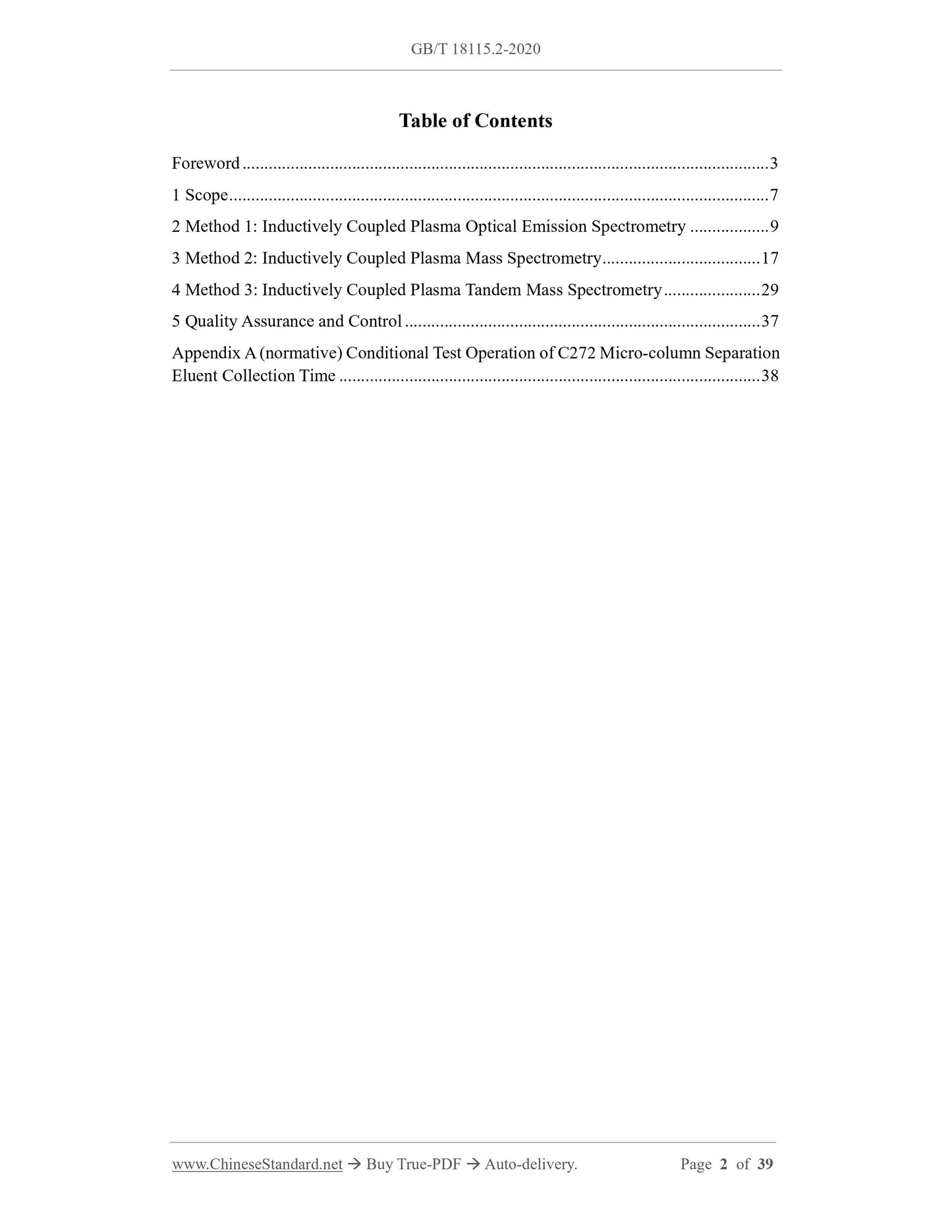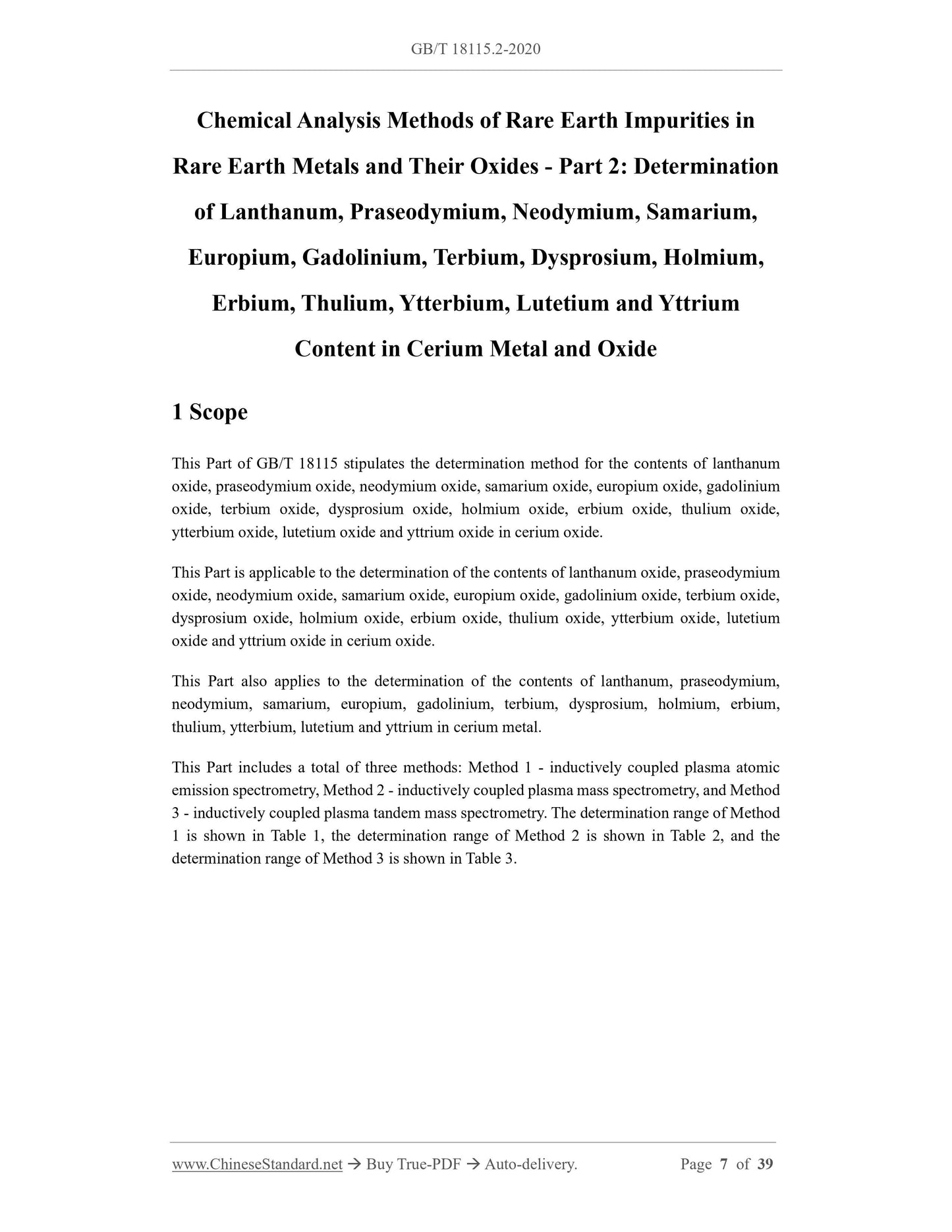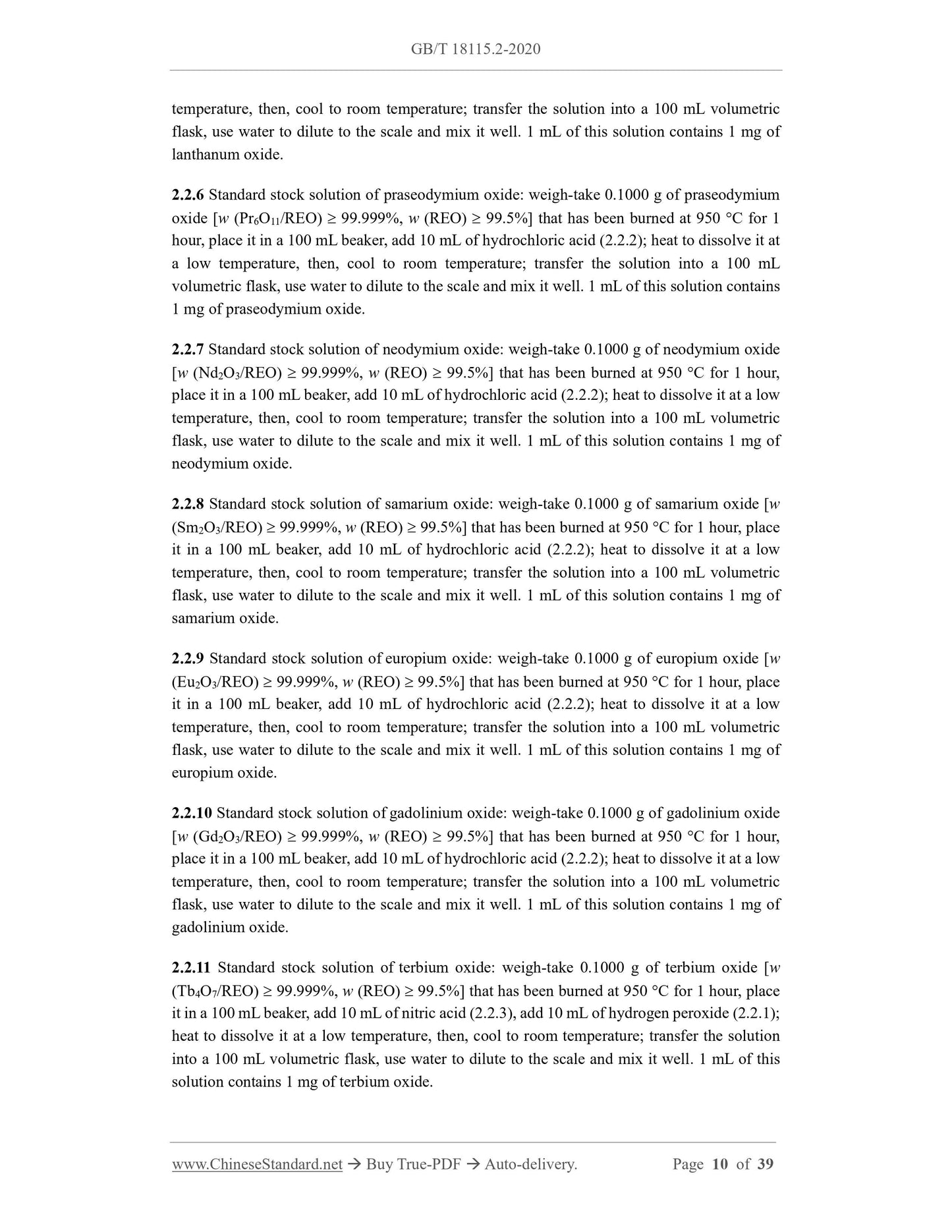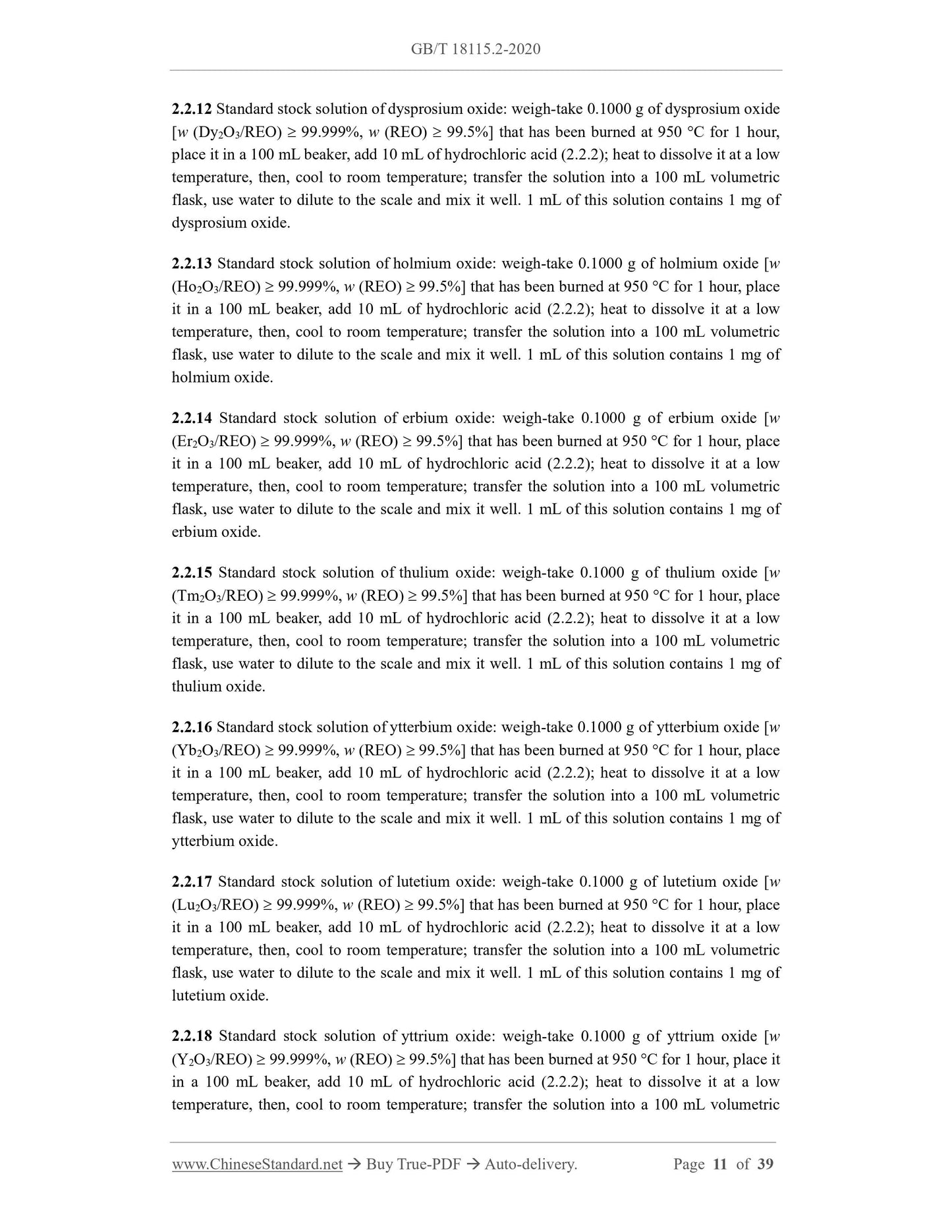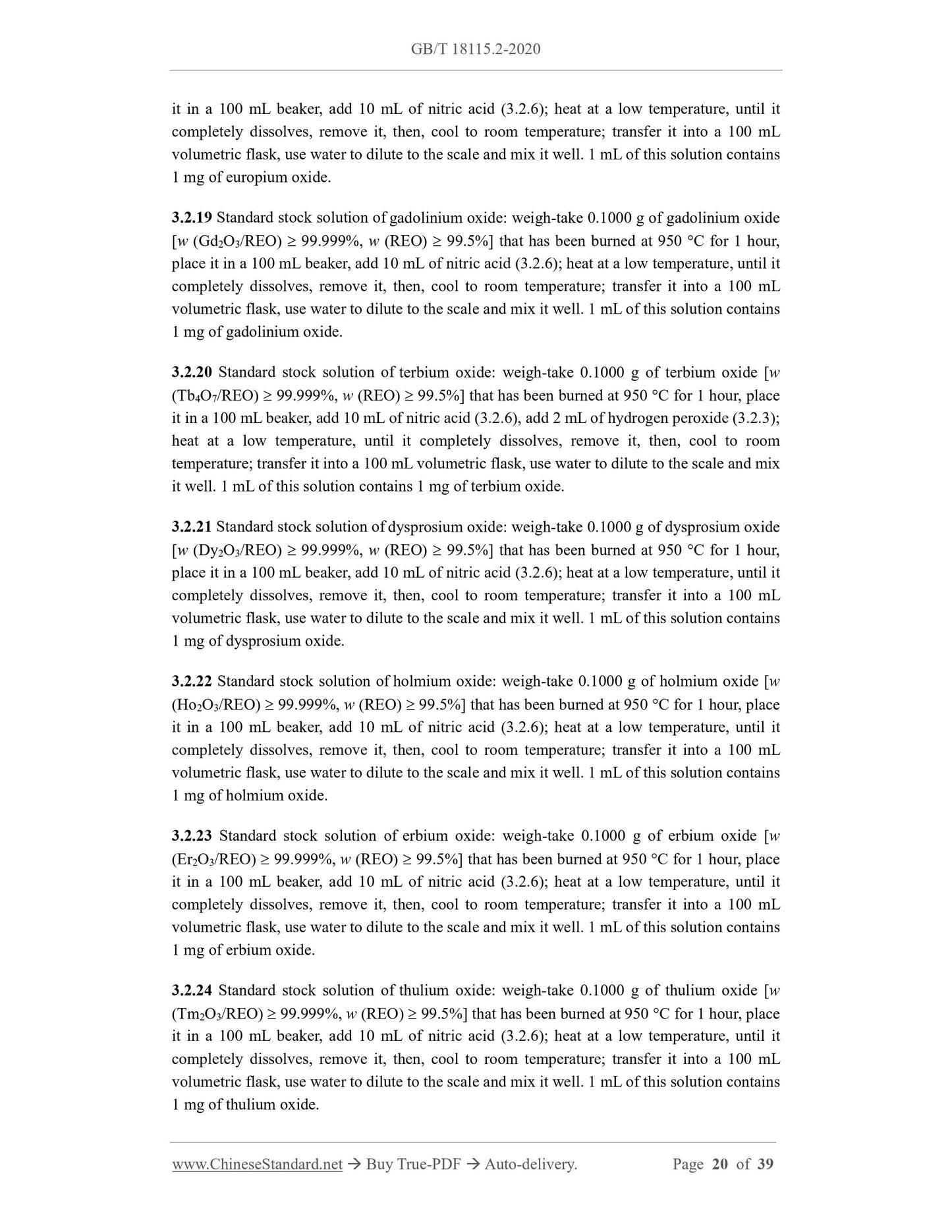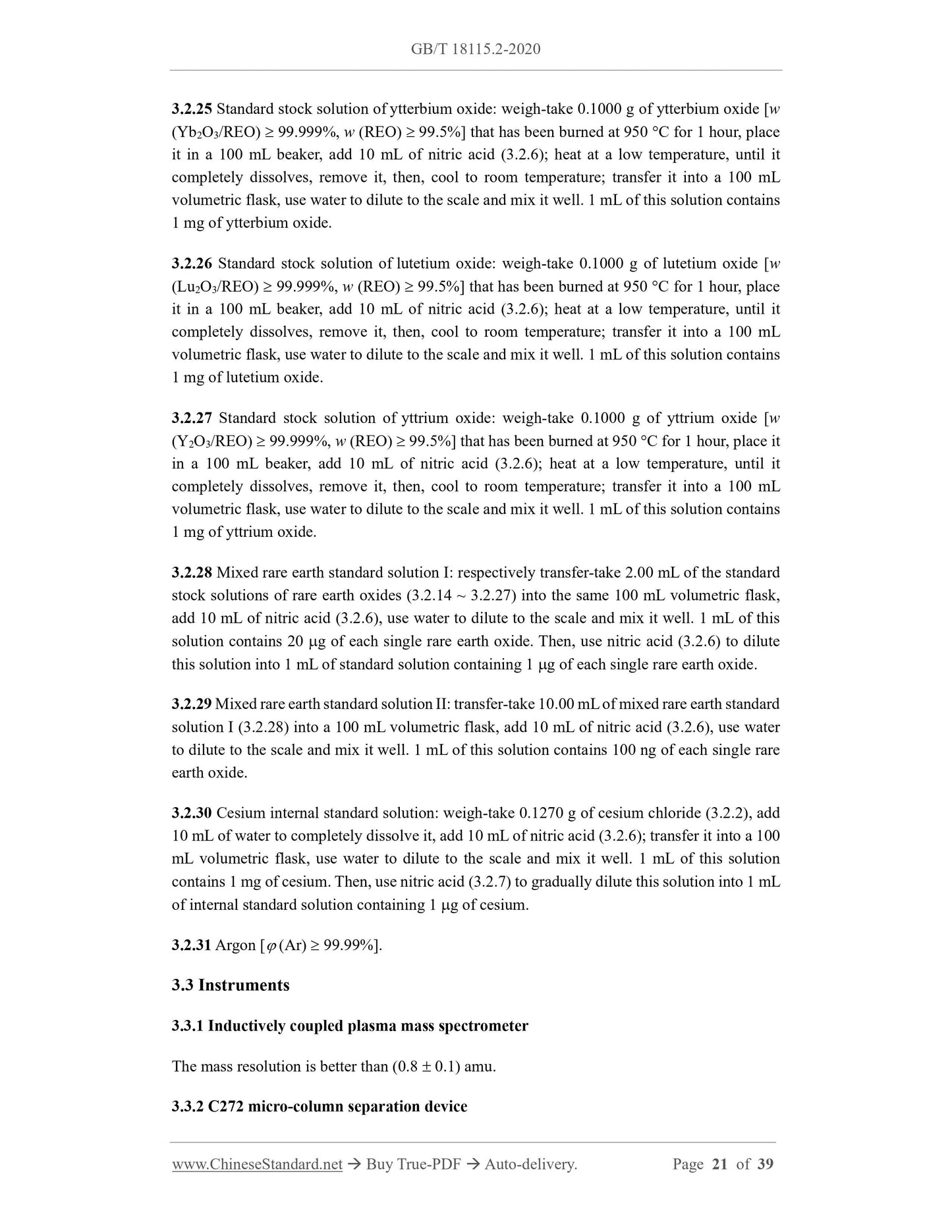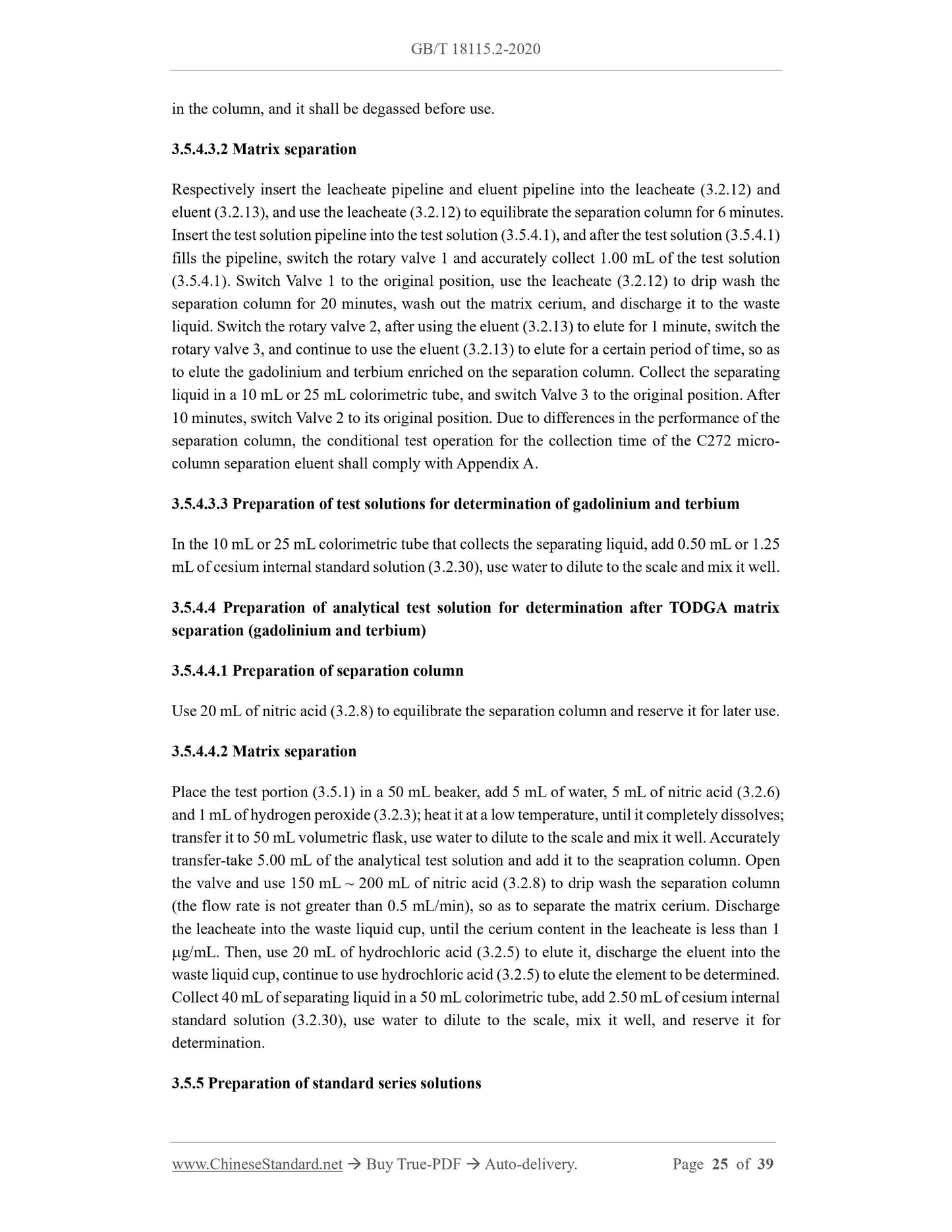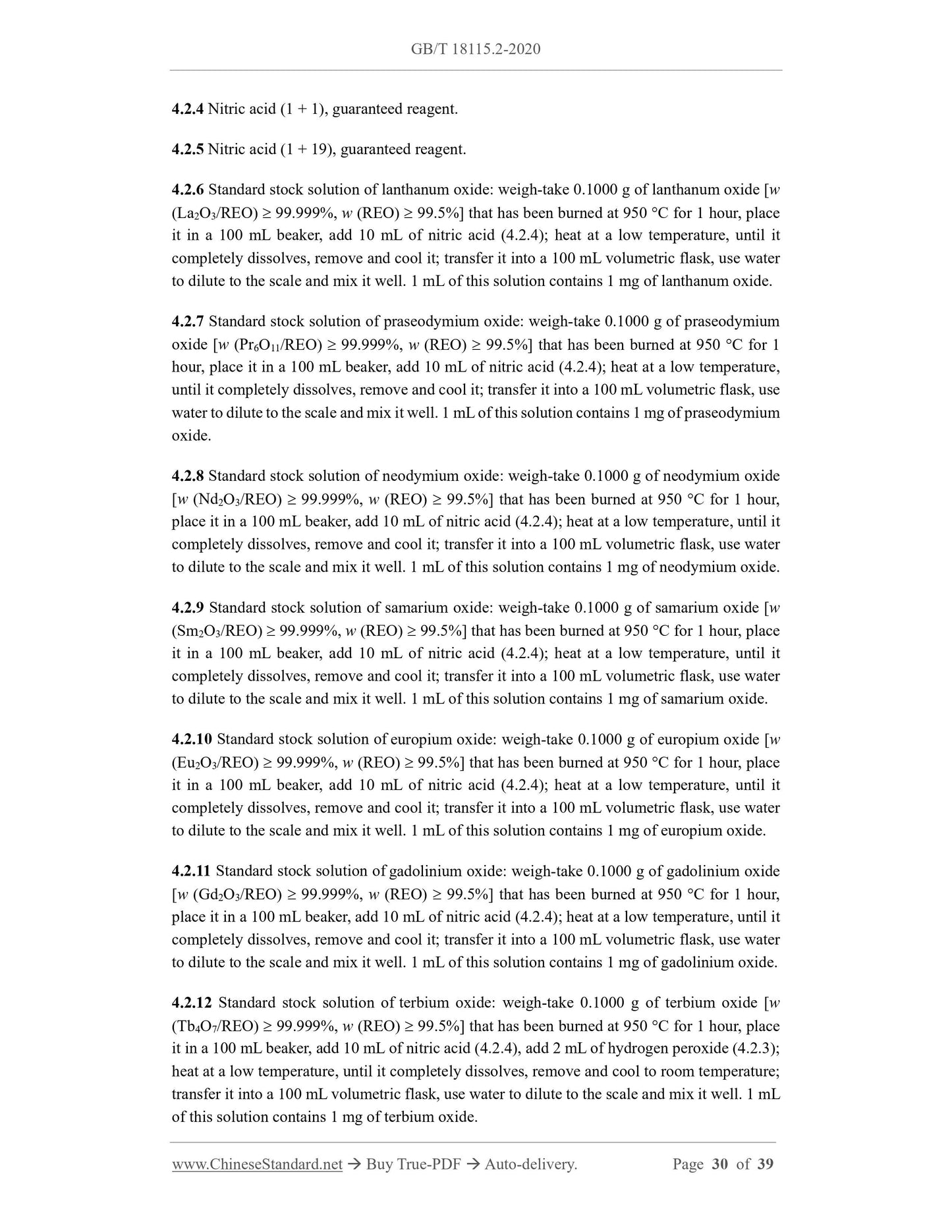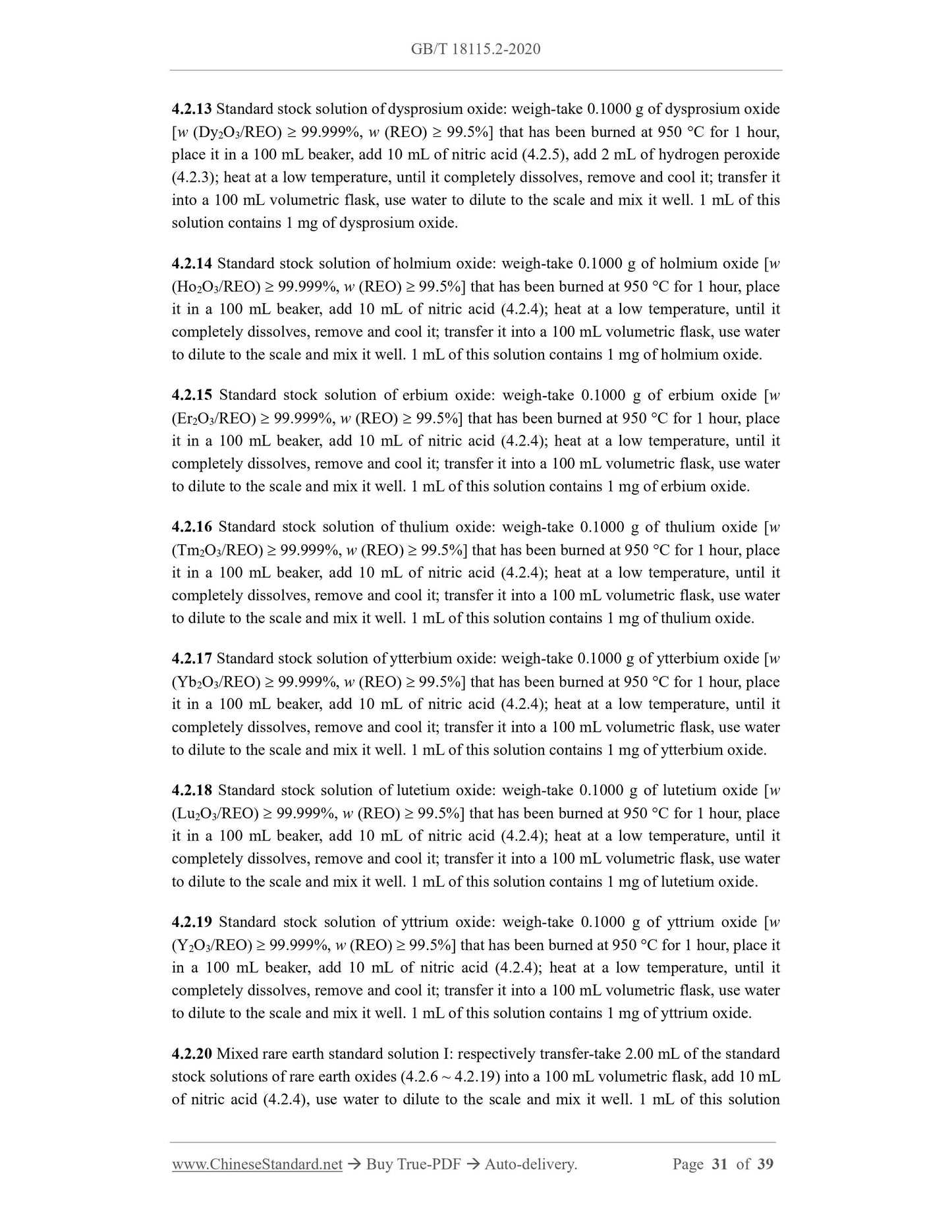Sales@ChineseStandard.net (Field Test Asia Pte. Ltd.)
GB/T 18115.2-2020 English PDF (GBT18115.2-2020)
GB/T 18115.2-2020 English PDF (GBT18115.2-2020)
Precio habitual
$405.00 USD
Precio habitual
Precio de oferta
$405.00 USD
Precio unitario
/
por
Los gastos de envío se calculan en la pantalla de pago.
No se pudo cargar la disponibilidad de retiro
Delivery: 3 seconds. Download true-PDF + Invoice.
Get QUOTATION in 1-minute: Click GB/T 18115.2-2020
Historical versions: GB/T 18115.2-2020
Preview True-PDF (Reload/Scroll if blank)
GB/T 18115.2-2020: Chemical analysis methods of rare earth impurities in rare earth metals and their oxides -- Part 2: Determination of lanthanum,praseodymium,neodymium,samarium,europium,gadolinium,terbium,dysprosium,holmium,erbium,thulium,ytterbium,lutetium and yttrium content in cerium metal and oxide
GB/T 18115.2-2020
GB
NATIONAL STANDARD OF THE
PEOPLE’S REPUBLIC OF CHINA
ICS 77.120.99
H 14
Replacing GB/T 18115.2-2006
Chemical Analysis Methods of Rare Earth Impurities in Rare Earth
Metals and Their Oxides - Part 2: Determination of Lanthanum,
Praseodymium, Neodymium, Samarium, Europium, Gadolinium,
Terbium, Dysprosium, Holmium, Erbium, Thulium, Ytterbium,
Lutetium and Yttrium Content in Cerium Metal and Oxide
ISSUED ON: NOVEMBER 19, 2020
IMPLEMENTED ON: OCTOBER 1, 2021
Issued by: State Administration for Market Regulation;
Standardization Administration of the People’s Republic of China.
Table of Contents
Foreword ... 3
1 Scope ... 7
2 Method 1: Inductively Coupled Plasma Optical Emission Spectrometry ... 9
3 Method 2: Inductively Coupled Plasma Mass Spectrometry ... 17
4 Method 3: Inductively Coupled Plasma Tandem Mass Spectrometry ... 29
5 Quality Assurance and Control ... 37
Appendix A (normative) Conditional Test Operation of C272 Micro-column Separation
Eluent Collection Time ... 38
Chemical Analysis Methods of Rare Earth Impurities in
Rare Earth Metals and Their Oxides - Part 2: Determination
of Lanthanum, Praseodymium, Neodymium, Samarium,
Europium, Gadolinium, Terbium, Dysprosium, Holmium,
Erbium, Thulium, Ytterbium, Lutetium and Yttrium
Content in Cerium Metal and Oxide
1 Scope
This Part of GB/T 18115 stipulates the determination method for the contents of lanthanum
oxide, praseodymium oxide, neodymium oxide, samarium oxide, europium oxide, gadolinium
oxide, terbium oxide, dysprosium oxide, holmium oxide, erbium oxide, thulium oxide,
ytterbium oxide, lutetium oxide and yttrium oxide in cerium oxide.
This Part is applicable to the determination of the contents of lanthanum oxide, praseodymium
oxide, neodymium oxide, samarium oxide, europium oxide, gadolinium oxide, terbium oxide,
dysprosium oxide, holmium oxide, erbium oxide, thulium oxide, ytterbium oxide, lutetium
oxide and yttrium oxide in cerium oxide.
This Part also applies to the determination of the contents of lanthanum, praseodymium,
neodymium, samarium, europium, gadolinium, terbium, dysprosium, holmium, erbium,
thulium, ytterbium, lutetium and yttrium in cerium metal.
This Part includes a total of three methods: Method 1 - inductively coupled plasma atomic
emission spectrometry, Method 2 - inductively coupled plasma mass spectrometry, and Method
3 - inductively coupled plasma tandem mass spectrometry. The determination range of Method
1 is shown in Table 1, the determination range of Method 2 is shown in Table 2, and the
determination range of Method 3 is shown in Table 3.
temperature, then, cool to room temperature; transfer the solution into a 100 mL volumetric
flask, use water to dilute to the scale and mix it well. 1 mL of this solution contains 1 mg of
lanthanum oxide.
2.2.6 Standard stock solution of praseodymium oxide: weigh-take 0.1000 g of praseodymium
oxide [w (Pr6O11/REO) 99.999%, w (REO) 99.5%] that has been burned at 950 C for 1
hour, place it in a 100 mL beaker, add 10 mL of hydrochloric acid (2.2.2); heat to dissolve it at
a low temperature, then, cool to room temperature; transfer the solution into a 100 mL
volumetric flask, use water to dilute to the scale and mix it well. 1 mL of this solution contains
1 mg of praseodymium oxide.
2.2.7 Standard stock solution of neodymium oxide: weigh-take 0.1000 g of neodymium oxide
[w (Nd2O3/REO) 99.999%, w (REO) 99.5%] that has been burned at 950 C for 1 hour,
place it in a 100 mL beaker, add 10 mL of hydrochloric acid (2.2.2); heat to dissolve it at a low
temperature, then, cool to room temperature; transfer the solution into a 100 mL volumetric
flask, use water to dilute to the scale and mix it well. 1 mL of this solution contains 1 mg of
neodymium oxide.
2.2.8 Standard stock solution of samarium oxide: weigh-take 0.1000 g of samarium oxide [w
(Sm2O3/REO) 99.999%, w (REO) 99.5%] that has been burned at 950 C for 1 hour, place
it in a 100 mL beaker, add 10 mL of hydrochloric acid (2.2.2); heat to dissolve it at a low
temperature, then, cool to room temperature; transfer the solution into a 100 mL volumetric
flask, use water to dilute to the scale and mix it well. 1 mL of this solution contains 1 mg of
samarium oxide.
2.2.9 Standard stock solution of europium oxide: weigh-take 0.1000 g of europium oxide [w
(Eu2O3/REO) 99.999%, w (REO) 99.5%] that has been burned at 950 C for 1 hour, place
it in a 100 mL beaker, add 10 mL of hydrochloric acid (2.2.2); heat to dissolve it at a low
temperature, then, cool to room temperature; transfer the solution into a 100 mL volumetric
flask, use water to dilute to the scale and mix it well. 1 mL of this solution contains 1 mg of
europium oxide.
2.2.10 Standard stock solution of gadolinium oxide: weigh-take 0.1000 g of gadolinium oxide
[w (Gd2O3/REO) 99.999%, w (REO) 99.5%] that has been burned at 950 C for 1 hour,
place it in a 100 mL beaker, add 10 mL of hydrochloric acid (2.2.2); heat to dissolve it at a low
temperature, then, cool to room temperature; transfer the solution into a 100 mL volumetric
flask, use water to dilute to the scale and mix it well. 1 mL of this solution contains 1 mg of
gadolinium oxide.
2.2.11 Standard stock solution of terbium oxide: weigh-take 0.1000 g of terbium oxide [w
(Tb4O7/REO) 99.999%, w (REO) 99.5%] that has been burned at 950 C for 1 hour, place
it in a 100 mL beaker, add 10 mL of nitric acid (2.2.3), add 10 mL of hydrogen peroxide (2.2.1);
heat to dissolve it at a low temperature, then, cool to room temperature; transfer the solution
into a 100 mL volumetric flask, use water to dilute to the scale and mix it well. 1 mL of this
solution contains 1 mg of terbium oxide.
2.2.12 Standard stock solution of dysprosium oxide: weigh-take 0.1000 g of dysprosium oxide
[w (Dy2O3/REO) 99.999%, w (REO) 99.5%] that has been burned at 950 C for 1 hour,
place it in a 100 mL beaker, add 10 mL of hydrochloric acid (2.2.2); heat to dissolve it at a low
temperature, then, cool to room temperature; transfer the solution into a 100 mL volumetric
flask, use water to dilute to the scale and mix it well. 1 mL of this solution contains 1 mg of
dysprosium oxide.
2.2.13 Standard stock solution of holmium oxide: weigh-take 0.1000 g of holmium oxide [w
(Ho2O3/REO) 99.999%, w (REO) 99.5%] that has been burned at 950 C for 1 hour, place
it in a 100 mL beaker, add 10 mL of hydrochloric acid (2.2.2); heat to dissolve it at a low
temperature, then, cool to room temperature; transfer the solution into a 100 mL volumetric
flask, use water to dilute to the scale and mix it well. 1 mL of this solution contains 1 mg of
holmium oxide.
2.2.14 Standard stock solution of erbium oxide: weigh-take 0.1000 g of erbium oxide [w
(Er2O3/REO) 99.999%, w (REO) 99.5%] that has been burned at 950 C for 1 hour, place
it in a 100 mL beaker, add 10 mL of hydrochloric acid (2.2.2); heat to dissolve it at a low
temperature, then, cool to room temperature; transfer the solution into a 100 mL volumetric
flask, use water to dilute to the scale and mix it well. 1 mL of this solution contains 1 mg of
erbium oxide.
2.2.15 Standard stock solution of thulium oxide: weigh-take 0.1000 g of thulium oxide [w
(Tm2O3/REO) 99.999%, w (REO) 99.5%] that has been burned at 950 C for 1 hour, place
it in a 100 mL beaker, add 10 mL of hydrochloric acid (2.2.2); heat to dissolve it at a low
temperature, then, cool to room temperature; transfer the solut...
Get QUOTATION in 1-minute: Click GB/T 18115.2-2020
Historical versions: GB/T 18115.2-2020
Preview True-PDF (Reload/Scroll if blank)
GB/T 18115.2-2020: Chemical analysis methods of rare earth impurities in rare earth metals and their oxides -- Part 2: Determination of lanthanum,praseodymium,neodymium,samarium,europium,gadolinium,terbium,dysprosium,holmium,erbium,thulium,ytterbium,lutetium and yttrium content in cerium metal and oxide
GB/T 18115.2-2020
GB
NATIONAL STANDARD OF THE
PEOPLE’S REPUBLIC OF CHINA
ICS 77.120.99
H 14
Replacing GB/T 18115.2-2006
Chemical Analysis Methods of Rare Earth Impurities in Rare Earth
Metals and Their Oxides - Part 2: Determination of Lanthanum,
Praseodymium, Neodymium, Samarium, Europium, Gadolinium,
Terbium, Dysprosium, Holmium, Erbium, Thulium, Ytterbium,
Lutetium and Yttrium Content in Cerium Metal and Oxide
ISSUED ON: NOVEMBER 19, 2020
IMPLEMENTED ON: OCTOBER 1, 2021
Issued by: State Administration for Market Regulation;
Standardization Administration of the People’s Republic of China.
Table of Contents
Foreword ... 3
1 Scope ... 7
2 Method 1: Inductively Coupled Plasma Optical Emission Spectrometry ... 9
3 Method 2: Inductively Coupled Plasma Mass Spectrometry ... 17
4 Method 3: Inductively Coupled Plasma Tandem Mass Spectrometry ... 29
5 Quality Assurance and Control ... 37
Appendix A (normative) Conditional Test Operation of C272 Micro-column Separation
Eluent Collection Time ... 38
Chemical Analysis Methods of Rare Earth Impurities in
Rare Earth Metals and Their Oxides - Part 2: Determination
of Lanthanum, Praseodymium, Neodymium, Samarium,
Europium, Gadolinium, Terbium, Dysprosium, Holmium,
Erbium, Thulium, Ytterbium, Lutetium and Yttrium
Content in Cerium Metal and Oxide
1 Scope
This Part of GB/T 18115 stipulates the determination method for the contents of lanthanum
oxide, praseodymium oxide, neodymium oxide, samarium oxide, europium oxide, gadolinium
oxide, terbium oxide, dysprosium oxide, holmium oxide, erbium oxide, thulium oxide,
ytterbium oxide, lutetium oxide and yttrium oxide in cerium oxide.
This Part is applicable to the determination of the contents of lanthanum oxide, praseodymium
oxide, neodymium oxide, samarium oxide, europium oxide, gadolinium oxide, terbium oxide,
dysprosium oxide, holmium oxide, erbium oxide, thulium oxide, ytterbium oxide, lutetium
oxide and yttrium oxide in cerium oxide.
This Part also applies to the determination of the contents of lanthanum, praseodymium,
neodymium, samarium, europium, gadolinium, terbium, dysprosium, holmium, erbium,
thulium, ytterbium, lutetium and yttrium in cerium metal.
This Part includes a total of three methods: Method 1 - inductively coupled plasma atomic
emission spectrometry, Method 2 - inductively coupled plasma mass spectrometry, and Method
3 - inductively coupled plasma tandem mass spectrometry. The determination range of Method
1 is shown in Table 1, the determination range of Method 2 is shown in Table 2, and the
determination range of Method 3 is shown in Table 3.
temperature, then, cool to room temperature; transfer the solution into a 100 mL volumetric
flask, use water to dilute to the scale and mix it well. 1 mL of this solution contains 1 mg of
lanthanum oxide.
2.2.6 Standard stock solution of praseodymium oxide: weigh-take 0.1000 g of praseodymium
oxide [w (Pr6O11/REO) 99.999%, w (REO) 99.5%] that has been burned at 950 C for 1
hour, place it in a 100 mL beaker, add 10 mL of hydrochloric acid (2.2.2); heat to dissolve it at
a low temperature, then, cool to room temperature; transfer the solution into a 100 mL
volumetric flask, use water to dilute to the scale and mix it well. 1 mL of this solution contains
1 mg of praseodymium oxide.
2.2.7 Standard stock solution of neodymium oxide: weigh-take 0.1000 g of neodymium oxide
[w (Nd2O3/REO) 99.999%, w (REO) 99.5%] that has been burned at 950 C for 1 hour,
place it in a 100 mL beaker, add 10 mL of hydrochloric acid (2.2.2); heat to dissolve it at a low
temperature, then, cool to room temperature; transfer the solution into a 100 mL volumetric
flask, use water to dilute to the scale and mix it well. 1 mL of this solution contains 1 mg of
neodymium oxide.
2.2.8 Standard stock solution of samarium oxide: weigh-take 0.1000 g of samarium oxide [w
(Sm2O3/REO) 99.999%, w (REO) 99.5%] that has been burned at 950 C for 1 hour, place
it in a 100 mL beaker, add 10 mL of hydrochloric acid (2.2.2); heat to dissolve it at a low
temperature, then, cool to room temperature; transfer the solution into a 100 mL volumetric
flask, use water to dilute to the scale and mix it well. 1 mL of this solution contains 1 mg of
samarium oxide.
2.2.9 Standard stock solution of europium oxide: weigh-take 0.1000 g of europium oxide [w
(Eu2O3/REO) 99.999%, w (REO) 99.5%] that has been burned at 950 C for 1 hour, place
it in a 100 mL beaker, add 10 mL of hydrochloric acid (2.2.2); heat to dissolve it at a low
temperature, then, cool to room temperature; transfer the solution into a 100 mL volumetric
flask, use water to dilute to the scale and mix it well. 1 mL of this solution contains 1 mg of
europium oxide.
2.2.10 Standard stock solution of gadolinium oxide: weigh-take 0.1000 g of gadolinium oxide
[w (Gd2O3/REO) 99.999%, w (REO) 99.5%] that has been burned at 950 C for 1 hour,
place it in a 100 mL beaker, add 10 mL of hydrochloric acid (2.2.2); heat to dissolve it at a low
temperature, then, cool to room temperature; transfer the solution into a 100 mL volumetric
flask, use water to dilute to the scale and mix it well. 1 mL of this solution contains 1 mg of
gadolinium oxide.
2.2.11 Standard stock solution of terbium oxide: weigh-take 0.1000 g of terbium oxide [w
(Tb4O7/REO) 99.999%, w (REO) 99.5%] that has been burned at 950 C for 1 hour, place
it in a 100 mL beaker, add 10 mL of nitric acid (2.2.3), add 10 mL of hydrogen peroxide (2.2.1);
heat to dissolve it at a low temperature, then, cool to room temperature; transfer the solution
into a 100 mL volumetric flask, use water to dilute to the scale and mix it well. 1 mL of this
solution contains 1 mg of terbium oxide.
2.2.12 Standard stock solution of dysprosium oxide: weigh-take 0.1000 g of dysprosium oxide
[w (Dy2O3/REO) 99.999%, w (REO) 99.5%] that has been burned at 950 C for 1 hour,
place it in a 100 mL beaker, add 10 mL of hydrochloric acid (2.2.2); heat to dissolve it at a low
temperature, then, cool to room temperature; transfer the solution into a 100 mL volumetric
flask, use water to dilute to the scale and mix it well. 1 mL of this solution contains 1 mg of
dysprosium oxide.
2.2.13 Standard stock solution of holmium oxide: weigh-take 0.1000 g of holmium oxide [w
(Ho2O3/REO) 99.999%, w (REO) 99.5%] that has been burned at 950 C for 1 hour, place
it in a 100 mL beaker, add 10 mL of hydrochloric acid (2.2.2); heat to dissolve it at a low
temperature, then, cool to room temperature; transfer the solution into a 100 mL volumetric
flask, use water to dilute to the scale and mix it well. 1 mL of this solution contains 1 mg of
holmium oxide.
2.2.14 Standard stock solution of erbium oxide: weigh-take 0.1000 g of erbium oxide [w
(Er2O3/REO) 99.999%, w (REO) 99.5%] that has been burned at 950 C for 1 hour, place
it in a 100 mL beaker, add 10 mL of hydrochloric acid (2.2.2); heat to dissolve it at a low
temperature, then, cool to room temperature; transfer the solution into a 100 mL volumetric
flask, use water to dilute to the scale and mix it well. 1 mL of this solution contains 1 mg of
erbium oxide.
2.2.15 Standard stock solution of thulium oxide: weigh-take 0.1000 g of thulium oxide [w
(Tm2O3/REO) 99.999%, w (REO) 99.5%] that has been burned at 950 C for 1 hour, place
it in a 100 mL beaker, add 10 mL of hydrochloric acid (2.2.2); heat to dissolve it at a low
temperature, then, cool to room temperature; transfer the solut...
Share
